
7 climbing plants with orange flowers to have in your garden
The most beautiful varieties of orange climbing plants
Contents
Whether they are salmon-orange, bright orange, or tangerine, the climbing plants with orange flowers are essential for energising any garden decor! Orange flowerings bring zest, cheerfulness, and vitality. Classic or original, they will adorn a pergola, wall, fence, trellis, or tree with their vibrant and warm hues, whether in full sun or partial shade. In a container on a terrace, you can also enjoy their fiery temperament!
Discover our selection of the most beautiful orange climbing plants in their genus!
Campsis radicans 'Madame Galen'
La Trumpet Vine or Campsis (x) tagliabuana ‘Madame Galen’, like all trumpet vines, is a generous climbing liana. Multiple times awarded and recognised by the Royal Horticultural Society in England, it is a reliable choice. This variety of trumpet vine with climbing roots bears trumpet-shaped flowers 7 to 8 cm long, in a beautiful bright orange tinged with salmon red, making it a radiant liana when in full flowering. The throat is slightly lighter.
The abundant flowering occurs from the first years after planting. It appears in ample, somewhat loose bouquets of 4 to 12 trumpets and lasts from July until September-October. The deciduous foliage, finely dissected, provides a bright light green backdrop to this warm flowering.
With rapid growth, it has a very bushy habit and will reach 10 m in all directions within a few years.
Hardy down to -20 °C, this old French cultivar thrives in all our regions, provided it is planted in a sheltered south-facing position, protected from the cold, drying winter winds that damage its flowering. It tolerates partial shade in our regions south of the Loire.
This variety of Campsis clings to any support and will joyfully flower on a pergola, wall, south-facing facade, fence, trellis, or even an old tree. You can pair it, for example, with other climbing plants like Akebia quinata, or with Clematis ‘H.F. Young’, a clematis with very large flowers of intense blue, to create a beautiful contrasting scene. Magnificent all summer long!
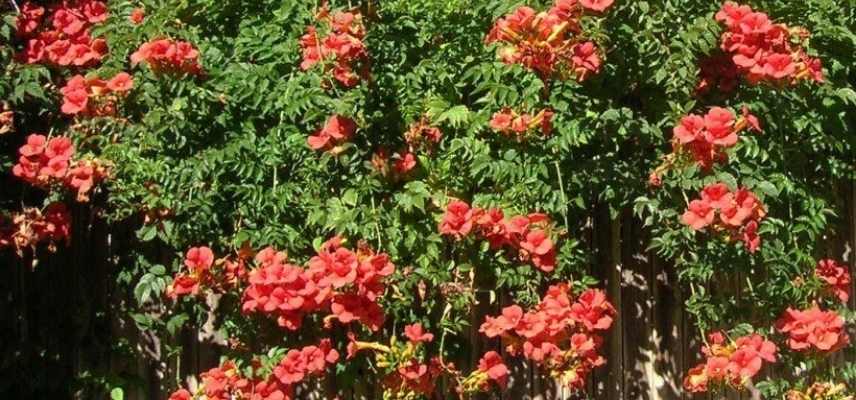
Trumpet Vine ‘Madame Galen’
Read also
10 climbing plants ideal for fencesBougainvillea spectabilis ‘Orange’
Here is another climbing plant appreciated for its exuberant summer flowering with pure, warm colours. It is one of the most remarkable lianas for gardens in mild climates. The Bougainvillea spectabilis ‘Orange’ stands out with the colour of its vibrant flowers. From May to September, it ensures a strong presence with its pretty little heart-shaped floral bracts in a beautiful, bright, warm orange, which can be seen from afar. They have a delicately crinkled appearance like silk. Throughout the beautiful season, the medium bright green foliage completely disappears under the avalanche of its flowers. It persists depending on the severity of the winter.
This species exhibits a stronger growth than other bougainvillea species, forming an average beautiful bush of 5 to 8 m in all directions.
Sensitive to cold, the bougainvillea should be grown in the ground only in our gardens spared from frost, in the so-called orange zone. Provide it with maximum sunlight and well-drained soil, even if poor and stony, without excess lime. In colder regions, this climbing plant can be grown in a pot on the terrace, to be brought in before the cold, just before autumn.
It vigorously covers a pergola, a large trellis, a fence, or even a south-facing wall of the house. If left untrained, it will form a large, original groundcover.
You can pair it with other generous climbing plants with exotic charm; it will look wonderful alongside the Plumbago auriculata, which has abundant summer and autumn flowering with small sky-blue flowers.
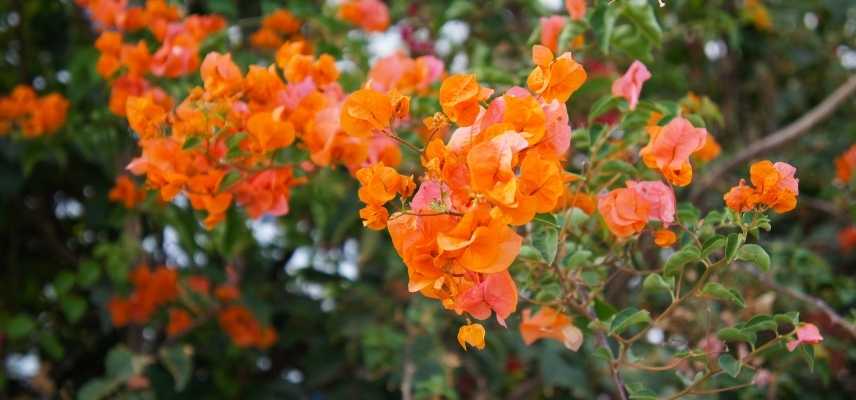
Bougainvillea spectabilis ‘Orange’
Discover other Climbers
View all →Available in 0 sizes
Available in 0 sizes
Available in 0 sizes
Available in 0 sizes
Available in 0 sizes
Available in 0 sizes
Available in 0 sizes
Available in 1 sizes
Available in 1 sizes
Available in 1 sizes
Tuberous nasturtium
The tuberous nasturtium is an ancient vegetable cultivated in the Andes for its edible tuber. Unjustly overlooked, it is also a stunning climbing plant that can easily reach 2.5 m in height under good conditions within just a few months!
It enchants us with its exotic, late but prolonged flowering, which appears at the very end of summer, in late August, and lasts until the first frosts. It only blooms in the second year of cultivation. At that point, it takes the form of long orange trumpets in the axils of the leaves. The flowers are characteristic of nasturtiums: formed of five round petals and equipped with a long spur reminiscent of the hood of a Capuchin monk’s robe. They bloom in a very bright orange, accented by a red calyx. Their throat is marked with dark orange. They stand proudly above the generous foliage thanks to long peduncles. The round, green deciduous leaves add a certain lushness to the plant and serve as a backdrop for the flowering.
The icing on the cake is that its flowers, leaves, and tubers are edible!
Semi-hardy, it only survives in the ground in mild climates. This perennial climber is often considered annual; plant it against a south-facing wall to improve its hardiness. Pot cultivation is possible. With its moderate growth, it is perfect for dressing up a trellis, pergola, or fence in an original way or covering the ground to create an astonishing floral carpet.
You will create an exotic duo by pairing it with other original climbers, such as Eccremocarpus scaber, a voluble climber with vermilion flowers.
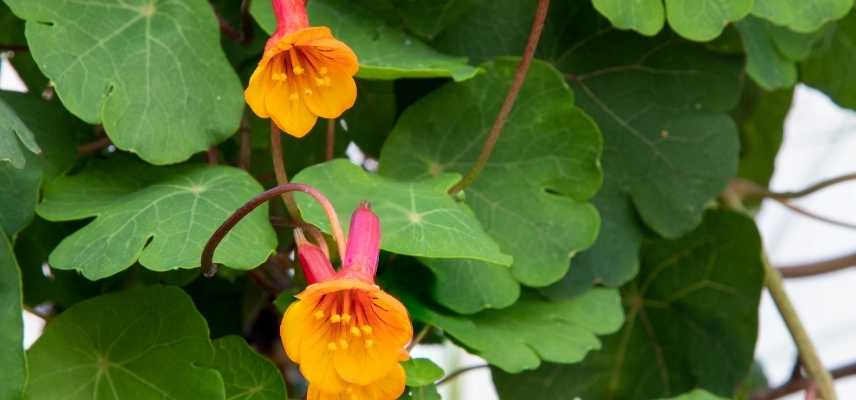
Tropaeolum tuberosum
The climbing honeysuckle 'Dropmore Scarlet'
Nothing beats a very hardy honeysuckle (down to -23.5 °C) for bringing warm colours to any garden. If you are looking for a vigorous climbing plant to enliven a semi-shaded area, Lonicera (x) brownii ‘Dropmore Scarlet’ is particularly suitable. Among its finest features are its repeat flowering in summer, blooming in June-July and then again in September-October. It appears in clusters of tubular flowers in scarlet red-orange. The lush foliage consists of bluish-green leaves that highlight the warm and vibrant colours of the flowers.
This hybrid variety, dating back to before 1950, is also valued for its vigorous growth, climbing rapidly on trellises, arbors, wooden fences, pergolas, or walls, reaching heights of up to 3.50 m and a spread of 2.50 m. It thrives in any good garden soil, tolerating the presence of lime well.
You can plant it alongside a climbing rose with white or light yellow flowers, or a clematis alpina ‘Francis Rivis’ with blue-violet flowers.
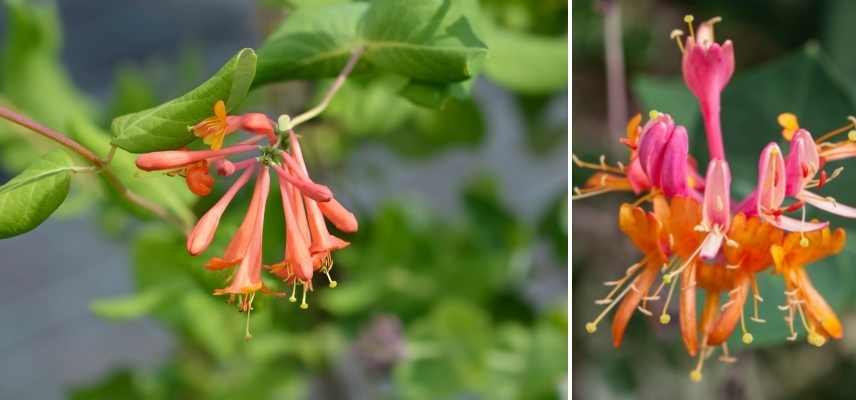
Lonicera ‘Dropmore Scarlet’
Tecomaria (or Tecoma) capensis
Rarely seen, not quite a climbing plant, nor entirely a Honeysuckle as its nickname “Cape Honeysuckle” might suggest… rather, it is a climbing sarmentous shrub, as it can grow up to 5 m maximum under good growing conditions, or 2.50 m if pruned annually. It is ideal if you are looking for a large format to adorn a wall, a hedge, or a large pergola in a mild climate. In a pot, it will not exceed 1.50 m in height with a spread of 1 m.
In reality, the Tecomaria capensis is a South African bignonia. It captivates at first glance with its long, narrow tube-like flowers of a very bright orange. These attract numerous pollinating insects and later transform into elongated, quite decorative pods. This warm flowering brightens up the late season, as the plant flowers late, from the end of August to early September, and continues until November if the weather is mild.
It quickly forms a large, bushy shrub that provides a welcoming habitat for birds, with foliage that persists in a mild winter.
Easy to grow in the ground in our temperate regions, this frost-sensitive plant (-7/-8 °C in very well-drained soil) also adapts to pot culture, to be wintered in colder areas.
In the garden or on the terrace, it pairs well with the blue flowers of the Ceratostigma griffitii, for example, another heat-loving shrub that bears small sky-blue flowers.

Tecoma capensis
Celastrus scandens ‘Autumn Revolution’
The Celastrus scandens ‘Autumn Revolution’ is a climbing plant perfect for adorning a pergola, gazebo, or wall from late summer until October. This extremely vigorous climbing bush forms rather slowly a large bush that can climb up to 6 m high in all directions.
Its unique fruiting is what makes it so appealing. The subtle orange flowering gives way around August to clusters of small, decorative, bright orange fruits that persist all winter along the naked branches, which birds love. All of this is enhanced by beautiful green deciduous foliage. They open at ripeness, revealing small orange or bright red beads. This particularly fruit-bearing variety of Celastrus is distinguished by its self-fertile character: there is no need for a male and female plant to produce fruit.
Very hardy (down to -30 °C), it can be grown anywhere in non-scorching sun or partial shade. Nicknamed “the tree killer” due to its invasive nature, we recommend planting it solitary, as it tends to hinder neighbouring plants. This way, you can fully enjoy its display!

Celastrus scandens ‘Autumn Revolution’
Black-eyed Susan ‘Superstar Orange’
The Black-eyed Susans are renowned for their typically orange flowers with a striking black centre. This Thunbergia alata ‘Superstar Orange’ is no exception, joyfully displaying its lovely bright orange flowers with a black pupil. The dark green, elongated heart-shaped foliage adds a touch of lushness to the plant and highlights the exotic colour and unique pattern of the flowers.
This charming climbing plant can reach a height of 2 m in just one summer! Its voluble stems need a support to cling to lovingly: fencing, a tipi, trellis, a fence, or a pyramid stake in the middle of a summer border… It can also be grown in a pot. Its flowering continues from June until the first frosts, and its rapid growth makes it an excellent choice for a temporary climber.
However, this elegant plant is frost-sensitive (-10 °C) and should be grown as an annual in the garden or kept in a pot in the conservatory, protected from frost. This tropical perennial requires warmth and sunlight to bloom well.
To give any support an exotic touch, you can pair it with a Campsis radicans or Trumpet Vine, or plant marigolds or red or blue salvias at its base to keep the soil cool in summer.
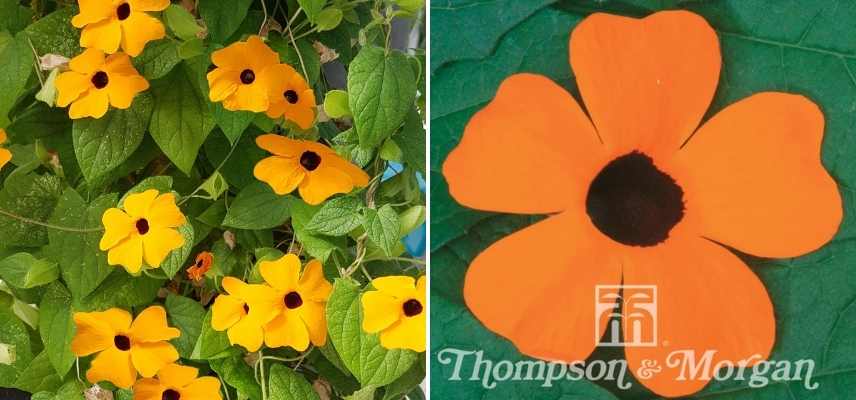
Thunbergia alata, with the variety ‘Superstar Orange’ on the right
- Subscribe!
- Contents
































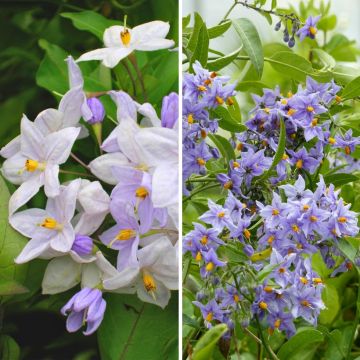
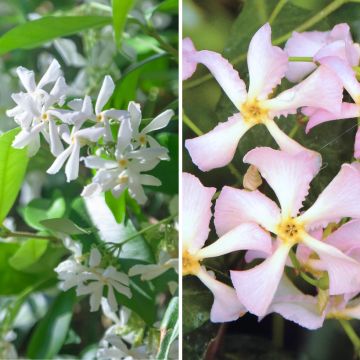
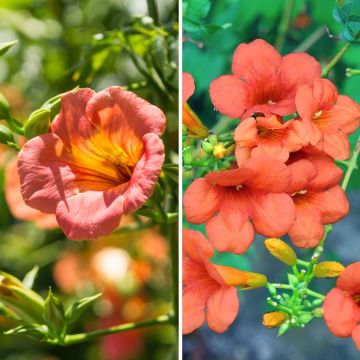
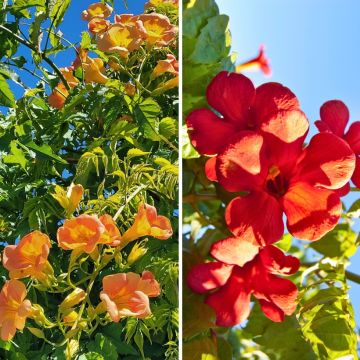
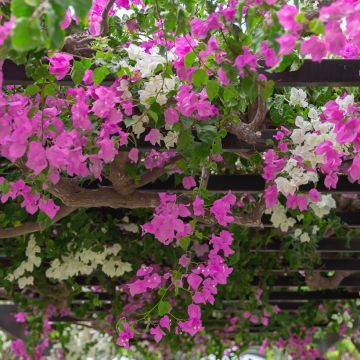
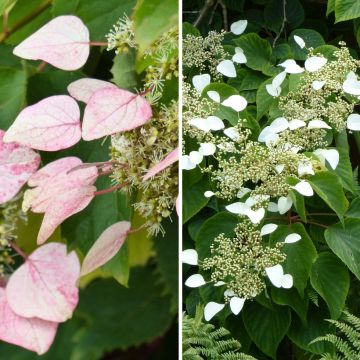
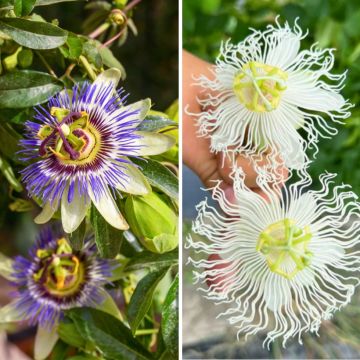
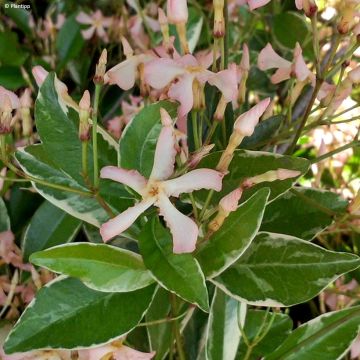
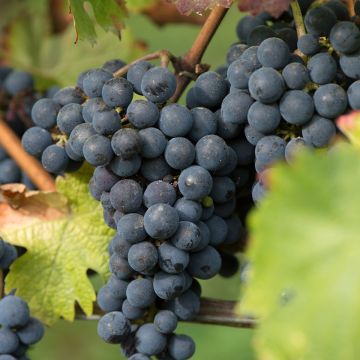
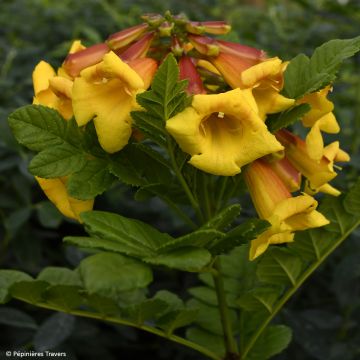
Comments